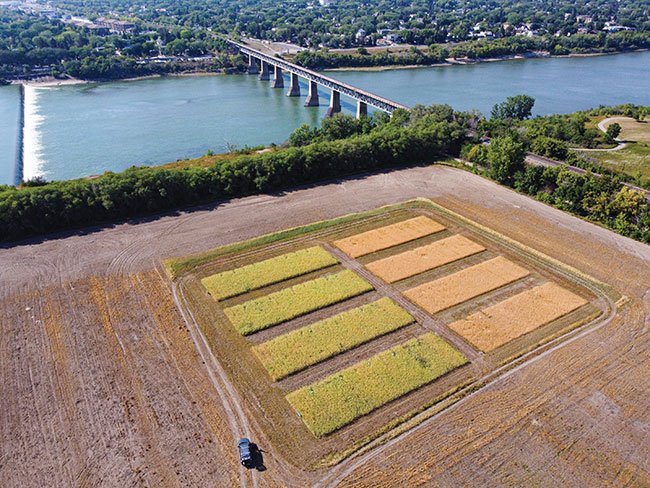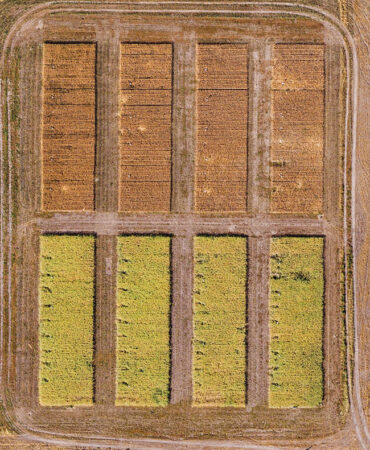
Features
Canola
Cereals
Fertility and Nutrients
Tools for maintaining yield while reducing N2O emissions in canola and wheat
Discovering the optimal rate of a dual-inhibitor N-fertilizer for maximum N2O emissions reduction.
February 8, 2023 By Donna Fleury
 Dual-inhibitor N-fertilizer study includes wheat and
canola grown in sequence.
Photo Credit: Frank Krijnen, University of Saskatchewan.
Dual-inhibitor N-fertilizer study includes wheat and
canola grown in sequence.
Photo Credit: Frank Krijnen, University of Saskatchewan. Researchers and industry are working to identify practical tools that Saskatchewan producers can employ to help them maintain or improve yields while simultaneously reducing N2O emissions from the use of N fertilizers.
One of the potential pathways is the adoption of dual-inhibitor N-fertilizer products. However, understanding the agri-environmental sweet spot for optimizing yield while maximizing N2O emissions reduction is still being evaluated.
“Agriculture production is one of the more vulnerable sectors facing climate change impacts, and identifying practical tools and options for reducing N2O emissions is important,” says Reynald Lemke, research scientist with Agriculture and Agri-Food Canada, in Saskatoon. “Enhanced efficiency fertilizer (EEF) products are one of the management tools that may help address N2O emissions. There are a number of EEF products available and generally research shows they do reduce N2O emissions. However, there is also a lot of variability in the results due to the various interactions of the products with weather patterns, climate conditions, cropping systems and many other factors.”
Lemke adds that for conditions in the Canadian Prairies, the results from the literature and studies they recently completed in Saskatchewan are quite promising and show that EEFs can lower N2O emissions by as much as 50 per cent compared to the same rate of urea. Although these results most often do not show significant agronomic benefits in terms of yield for the area, there are indications there may be benefits in terms of nitrogen use efficiency (NUE). This raises the question of whether lower rates of EEF N-fertilizer products could be applied without causing a yield penalty.
To address these questions, Lemke, in collaboration with Richard Farrell and other colleagues at the University of Saskatchewan, initiated a three-year study at two locations in Saskatchewan. Field experiments are being conducted at Saskatoon and Melfort to provide a comparison of different soil and environmental conditions under dark brown and black soils. The main objective is to evaluate whether a dual inhibitor N-fertilizer product can be applied at a reduced N-rate as compared to urea while maintaining optimal yield for wheat and canola. Researchers are also trying to determine the maximum N2O emissions-reduction that can be achieved with a dual-inhibitor N-fertilizer as compared to urea. A third objective is to determine the agri-environmental optimum N-rate for a dual-inhibitor N-fertilizer as an N-source for canola.

Dual-inhibitor N-fertilizer study includes wheat and canola grown in sequence.
Photo Credit: Frank Krijnen, University of Saskatchewan.
“For the study, we selected a dual-inhibitor product that includes both nitrification and urease inhibitors, which would reduce the risk of volatilization,” explains Lemke. “We selected this product because the results from a previous study and other studies in this region show this product tends to provide the most consistent response. Other single nitrification inhibitor products can be quite variable, sometimes providing higher N2O reductions but sometimes lower. This study is really a rate study, with the dual-inhibitor N-fertilizer product applied at the recommended rate based on a soil test and a reasonable yield target, and compared to rates at 90, 80 and 70 per cent of the recommended rate. For reference, urea fertilizer treatments are included at the same rates for comparison. All other management practices are the same.” Wheat and canola are grown in sequence at both locations. Agronomic factors including yield and partial N-balance results will be measured for both crops.
However, due to logistics and intensive labour requirements, N2O gas sampling to measure greenhouse gasses will only be measured on canola plots. The study was in its first year in 2022, with the final cropping year to be completed in 2023. Preliminary study results are just being collected and an early analysis is underway.
“Once we have the results from the study, we will have good evidence of how this product would work and the environmental consequences,” says Lemke. “Identifying the agri-environmental sweet spot for dual-inhibitor N-fertilizers and what benefit we might get in N2O emissions reduction for canola and wheat is the first step. And, if for example, the results show that the same crop yields can be achieved using an 80 per cent rate of a dual-inhibitor product, this may offset some of the higher costs of the product. Through this project and others underway, we expect to be able to identify practical tools that producers can employ to help them maintain or improve yields while simultaneously reducing N2O emissions.”